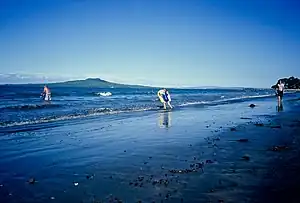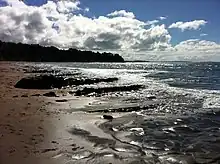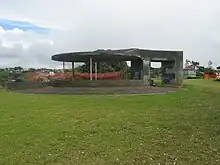Castor Bay
Castor Bay is a bay and suburb of the North Shore, located in Auckland which is in the North Island of New Zealand. Located between Milford and Campbells Bay, it is part of the East Coast Bays. To the east lies the islands of Rangitoto and Motutapu, which are easily visible from land. The suburb is in the North Shore ward, one of the thirteen administrative divisions of Auckland Council.
Castor Bay | |
|---|---|
 Castor Bay beach | |
| Coordinates: 36.762°S 174.766°E | |
| Country | New Zealand |
| City | Auckland |
| Local authority | Auckland Council |
| Electoral ward | North Shore ward |
| Local board | Devonport-Takapuna Local Board |
| Area | |
| • Land | 144 ha (356 acres) |
| Population (June 2023)[2] | |
| • Total | 1,710 |
| Postcode(s) | 0620[3] |
| Sunnynook | Campbells Bay | (Hauraki Gulf) |
| Forrest Hill |
|
(Hauraki Gulf) |
| Westlake | Milford | (Hauraki Gulf) |
The bay itself is quite small and is well sheltered by an artificial breakwater that extends from the northern edge of the bay, running towards the south. A small bark and grass area with several large pohutukawa trees offering shelter complements the beachfront and an extended coastline stretches out to the north towards Campbells Bay.
Geography

Castor Bay is located on the east coast of the North Shore, between Campbells Bay and Milford.[4] The bay to the east shares the same name as the suburb, and looks out towards Rangitoto.[5] The point to the east of Castor Bay is called Rahopara Point,[6] and the river at the southern border of the suburb is called Wairau Creek.[7]
The land is primarily formed from clay and Waitemata sandstone, which can be seen in the cliffs along the coast.[8] Prior to human settlement, the inland Castor Bay area was primarily a northern broadleaf podocarp forest, dominated by kauri, tōtara, mataī, miro, kauri and kahikatea trees. Pōhutukawa trees were a major feature of the coastline.[9][10]
History
Māori history
.jpg.webp)
Māori settlement of the Auckland Region began around the 13th or 14th centuries.[11][12] The North Shore was settled by Tāmaki Māori, including people descended from the Tainui migratory canoe and ancestors of figures such as Taikehu and Peretū.[13] Many of the Tāmaki Māori people of the North Shore identified as Ngā Oho.[14] While the poor soils in the area hindered dense settlement,[8] traditional resources in the area included fish, shellfish and marine birds.[15]
The warrior Maki migrated from the Kāwhia Harbour to his ancestral home in the Auckland Region, likely sometime in the 17th century. Maki conquered and unified many the Tāmaki Māori tribes as Te Kawerau ā Maki, including those of the North Shore.[16][17] After Maki's death, his sons settled different areas of his lands, creating new hapū. His younger son Maraeariki settled the North Shore and Hibiscus Coast, who based himself at the head of the Ōrewa River. Maraeariki's daughter Kahu succeeded him, and she is the namesake of the North Shore, Te Whenua Roa o Kahu ("The Greater Lands of Kahu").[18][19] Many of the iwi of the North Shore, including Ngāti Manuhiri, Ngāti Maraeariki, Ngāti Kahu, Ngāti Poataniwha, Ngāi Tai Ki Tāmaki and Ngāti Whātua, can trace their lineage to Kahu.[19][20]
The northern headland of Castor Bay is the site of an old Maori pā, Rahopara, also known as Te Rahopara o Peretū.[21] Archaeological studies have dated an earth oven at the site to between the mid-15th and mid-16th centuries,[22] and generations of Tāmaki Māori adapted the defenses of the pā over time.[21] The name of the pā is associated with Peretū,[21] an ancestor of the Ngāi Tai ki Tāmaki people,[23] and the pā was known as a defensive stronghold of Te Kawerau ā Maki.[24] Traditional histories recount Te Patukirikiri ancestor Kapetaua sacking the pā in the 17th century, as revenge for being marooned at Te Toka-o-Kapetaua (Bean Rock).[21][25] A second pā known as Wairoa Pā was located further south, at the headland overlooking the mouth of the Wairau Creek.[26]
By the 18th century, the Marutūāhu iwi Ngāti Paoa had expanded their influence to include the islands of the Hauraki Gulf and the North Shore.[27] After periods of conflict, peace had been reached by the 1790s.[28] The earliest contact with Europeans began in the late 18th century, which caused many Tāmaki Māori to die of rewharewha, respiratory diseases.[29] During the early 1820s, most Māori of the North Shore fled for the Waikato or Northland due to the threat of war parties during the Musket Wars. Most people had returned by the late 1820s and 1830s.[12][27][30]
European settlement

.jpg.webp)
In 1841, the Crown purchased the Mahurangi and Omaha blocks; an area that spanned from Takapuna to Te Arai. The purchase involved some iwi with customary interests in the area, such as Ngāti Paoa, other Marutūāhu iwi and Ngāi Tai ki Tāmaki, but not others, such as Te Kawerau ā Maki or Ngāti Rango.[31][32][20][33] The Crown spent until 1873 rectifying this sale, by making further deals with stakeholders.[32][33]
Castor Bay was originally known as Castor Oil Bay, after an early settler planted castor bean trees on the hillsides of the area.[34][35] The name Castor Bay started to be used from the 1910s, and from the mid-1910s the area was subdivided by the Castor Oil Bay Land Company.[36] By the early 20th century, the bay had become a popular destination for daytrippers and holiday makers, and holiday baches were constructed here.[37][34] In the 1920s, the bay became a popular with New Zealand literary figures, after resident Jane Stronach made her bach available to people including poet D'Arcy Cresswell, novelist Jane Mander and poet R. A. K. Mason.[34]
During World War II, the Castor Bay Battery and Camp was built during World War II, to protect the Rangitoto Channel.[21] The site was originally purchased by the Army in 1934,[38] and the military buildings were disguised as a state housing project.[34] The site was decommissioned in 1957, and given to the Takapuna City Council in 1966, becoming the JF Kennedy Memorial Park.[38]
After the construction of the Auckland Harbour Bridge in 1959, the area developed further, and the first convenience stores opened in Castor Bay.[34] The Rahopara pā archaeological site was almost destroyed in 1965, as the earthworks were planned to be excavated and used as fill for a marina. Plans for this were cancelled after lobbying by archaeologists and local residents.[21]
Demographics
Castor Bay covers 1.44 km2 (0.56 sq mi)[1] and had an estimated population of as of June 2023,[2] with a population density of Formatting error: invalid input when rounding people per km2.
| Year | Pop. | ±% p.a. |
|---|---|---|
| 2006 | 4,116 | — |
| 2013 | 4,305 | +0.64% |
| 2018 | 4,509 | +0.93% |
| Source: [39] | ||
Castor Bay had a population of 4,509 at the 2018 New Zealand census, an increase of 204 people (4.7%) since the 2013 census, and an increase of 393 people (9.5%) since the 2006 census. There were 1,563 households, comprising 2,184 males and 2,322 females, giving a sex ratio of 0.94 males per female. The median age was 42.0 years (compared with 37.4 years nationally), with 810 people (18.0%) aged under 15 years, 798 (17.7%) aged 15 to 29, 2,190 (48.6%) aged 30 to 64, and 708 (15.7%) aged 65 or older.
Ethnicities were 76.2% European/Pākehā, 3.9% Māori, 1.2% Pacific peoples, 21.5% Asian, and 2.9% other ethnicities. People may identify with more than one ethnicity.
The percentage of people born overseas was 39.5, compared with 27.1% nationally.
Although some people chose not to answer the census's question about religious affiliation, 54.2% had no religion, 35.7% were Christian, 0.5% were Hindu, 1.1% were Muslim, 1.3% were Buddhist and 2.1% had other religions.
Of those at least 15 years old, 1,449 (39.2%) people had a bachelor's or higher degree, and 237 (6.4%) people had no formal qualifications. The median income was $46,600, compared with $31,800 nationally. 1,233 people (33.3%) earned over $70,000 compared to 17.2% nationally. The employment status of those at least 15 was that 1,899 (51.3%) people were employed full-time, 567 (15.3%) were part-time, and 105 (2.8%) were unemployed.[39]
Education
The local primary school is Campbells Bay Primary School located on Aberdeen Road, nearby the Pupuke Golf Course. It has a roll of 812 as of April 2023.[40][41] The school opened in 1925.[42]
Local government
From 1876 until 1954, the area was administered by the Waitemata County, a large rural county north and west of the city of Auckland.[43] In 1954, Castor Bay was added to the Borough of Takapuna,[44] which became Takapuna City in 1961.[34] In 1989, the city was merged into the North Shore City.[45] North Shore City was amalgamated into Auckland Council in November 2010.[46]
Within the Auckland Council, Castor Bay is a part of the Devonport-Takapuna local government area governed by the Devonport-Takapuna Local Board. It is a part of the North Shore ward, which elects two councillors to the Auckland Council.
Notable people
- Sam Hunt, one of New Zealand's most well known poets, was born in Castor Bay.[34]
- Robin Hyde, South African-born New Zealand poet.[47]
Notes
- "ArcGIS Web Application". statsnz.maps.arcgis.com. Retrieved 24 June 2022.
- "Population estimate tables - NZ.Stat". Statistics New Zealand. Retrieved 25 October 2023.
- "Search Result - auckland castor bay Auckland - Page 1 - New Zealand Postcode".
- "Castor Bay". New Zealand Gazetteer. Land Information New Zealand. Retrieved 11 July 2023.
- "Castor Bay". New Zealand Gazetteer. Land Information New Zealand. Retrieved 11 July 2023.
- "Rahopara Point". New Zealand Gazetteer. Land Information New Zealand. Retrieved 11 July 2023.
- "Wairau Creek". New Zealand Gazetteer. Land Information New Zealand. Retrieved 11 July 2023.
- Heritage Consultancy Services (1 July 2011). North Shore Heritage - Thematic Review Report Volume 1 (PDF) (Report). Auckland Council. ISBN 978-1-927169-21-6. Retrieved 29 June 2023.
- Veart, Dave (2018). The Māori Archaeology of Te Raki Paewhenua/North Shore (Report). Auckland North Community and Development. p. 10. ISBN 978-0-9941358-4-1.
- Willis 2018, pp. 2.
- Pishief, Elizabeth; Shirley, Brendan (August 2015). "Waikōwhai Coast Heritage Study" (PDF). Auckland Council. Retrieved 14 February 2023.
- Boffa Miskell. Penlink Cultural & Environmental Design Framework: Penlink Cultural and Environmental Context (PDF) (Report). Waka Kotahi NZ Transport Agency. Retrieved 4 July 2023.
- Ngāi Tai ki Tāmaki (April 2016). Cultural Values Assessment Report to New Zealand Transport Agency for Northern Corridor Improvements Project (NCI) (PDF) (Report). NZ Transport Agency. Retrieved 30 June 2023.
- Mossman, Sarah (August 2018). Cultural Values Assessment for America's Cup 36 - Wynyard and Hobson Planning Application (PDF). Te Kawerau Iwi Tribunal Authority (Report). Retrieved 30 June 2023.
- McKenzie, Fiona (June 2016). Cultural Impact Assessment for the NZ Transport Agency's Northern Corridor Improvements (PDF). Manuhiri Kaitiaki Charitable Trust (Report). NZ Transport Agency. Retrieved 30 June 2023.
- "Waitākere Ranges Heritage Area" (PDF). Auckland Council. December 2018. Retrieved 28 June 2021.
- Murdoch, Graeme (1990). "Nga Tohu o Waitakere: the Maori Place Names of the Waitakere River Valley and its Environs; their Background History and an Explanation of their Meaning". In Northcote-Bade, James (ed.). West Auckland Remembers, Volume 1. West Auckland Historical Society. p. 13-14. ISBN 0-473-00983-8.
- Ngāti Manuhiri; The Crown (21 May 2011). "Deed of Settlement of Historical Claims" (PDF). New Zealand Government. Retrieved 18 May 2022.
- Whaanga, Mel (March 2022). "He taonga o te rohe". Restore Hibiscus & Bays. Retrieved 30 June 2023.
- Ngāi Tai Ki Tāmaki and the Trustees of the Ngāi Tai Ki Tāmaki Trust and the Crown (7 November 2015). "Deed of settlement schedule documents" (PDF). NZ Government. Archived (PDF) from the original on 13 February 2020. Retrieved 31 October 2021.
- Cameron, Ewen; Hayward, Bruce; Murdoch, Graeme (2008). A Field Guide to Auckland: Exploring the Region's Natural and Historical Heritage (rev. ed.). Random House New Zealand. p. 137. ISBN 978-1-86962-1513.
- Bulmer, Susan (March 1994). Sources for the Archaeology of the Maaori Settlement of the Taamaki Volcanic District (PDF) (Report). Wellington: Department of Conservation. p. 56. ISBN 0-478-01552-6.
- "About Rangitoto Island". Te Haerenga. Retrieved 8 September 2022.
- Lutz, Heike; Chan, Theresa (2011). North Shore heritage – North Shore area studies and scheduled items list: volume 2 parts 6+ (PDF). Heritage Consultancy Services (Report). Auckland Council. Retrieved 7 July 2023.
- Royal, Te Ahukaramū Charles (3 March 2017). "Hauraki tribes - The first tribes". Te Ara: The Encyclopedia of New Zealand. Ministry for Culture and Heritage. Retrieved 17 December 2021.
- Schedule 14.1 Schedule of Historic Heritage (PDF) (Report). Auckland Council. Retrieved 20 September 2023.
- New Zealand Government; Ngāti Paoa (20 March 2021). "Ngāti Pāoa and the Trustees of the Ngāti Pāoa Iwi Trust and The Crown Deed of Settlement of Historical Claims" (PDF). New Zealand Government. Retrieved 1 September 2021.
- "Wenderholm Regional Park: Our History" (PDF). Auckland Council. 2015. Retrieved 4 May 2023.
- McKenzie, Fiona (May 2017). "Cultural Values Assessment for the Warkworth North Structure Plan and Associated Development" (PDF). Manuhiri Kaitiaki Charitable Trust. Auckland Council. Retrieved 4 July 2023.
- Ngāti Manuhiri; The Crown (21 May 2011). "Deed of Settlement of Historical Claims" (PDF). New Zealand Government. Retrieved 18 May 2022.
- Rigby, Barry (August 1998). The Crown, Maori and Mahurangi 1840-1881 (PDF) (Report). Waitangi Tribunal. Retrieved 4 July 2023.
- Stone 2001, pp. 188.
- Te Kawerau ā Maki; The Trustees of Te Kawerau Iwi Settlement Trust; The Crown (22 February 2014). "Deed of Settlement of Historical Claim" (PDF). Retrieved 4 July 2023.
- Heritage Consultancy Services (1 July 2011). North Shore Heritage, Volume 2: North Shore Area Studied & Scheduled Items List (PDF) (Report). Auckland Council. ISBN 978-1-927169-23-0. Retrieved 13 July 2023.
- Verran, David 2010, pp. 37.
- Verran, David (December 2017). "Early Castor Bay, to the 1950s". Channel Magazine. Retrieved 13 July 2023.
- Verran, David 2010, pp. 111.
- Verran, David 2010, pp. 104.
- "Statistical area 1 dataset for 2018 Census". Statistics New Zealand. March 2020. Castor Bay (123700). 2018 Census place summary: Castor Bay
- "New Zealand Schools Directory". New Zealand Ministry of Education. Retrieved 12 December 2022.
- Education Counts: Campbells Bay School
- "Jubilees & reunions - Campbells Bay School". Education Gazette New Zealand. 78 (11). 5 July 1999.
- Reidy, Jade (2009). "How the West Was Run". In Macdonald, Finlay; Kerr, Ruth (eds.). West: The History of Waitakere. Random House. pp. 238–239. ISBN 9781869790080.
- Verran, David 2010, pp. 253.
- Mace, Tania (October 2006). "Browns Bay Heritage Walk" (PDF). North Shore City Council. Retrieved 4 July 2023.
- Blakeley, Roger (2015). "The planning framework for Auckland 'super city': an insider's view". Policy Quarterly. 11 (4). doi:10.26686/pq.v11i4.4572. ISSN 2324-1101.
- Verran, David 2010, pp. 266.
Bibliography
- Stone, R. C. J. (2001). From Tamaki-makau-rau to Auckland. Auckland University Press. ISBN 1869402596.
- Verran, David (2010). The North Shore: An Illustrated History. North Shore: Random House. ISBN 978-1-86979-312-8. OCLC 650320207. Wikidata Q120520385.
- Willis, Jenny (2018). Early History of East Coast Bays (Second ed.).
External links
- Campbells Bay School website
- Photographs of Castor Bay held in Auckland Libraries' heritage collections.